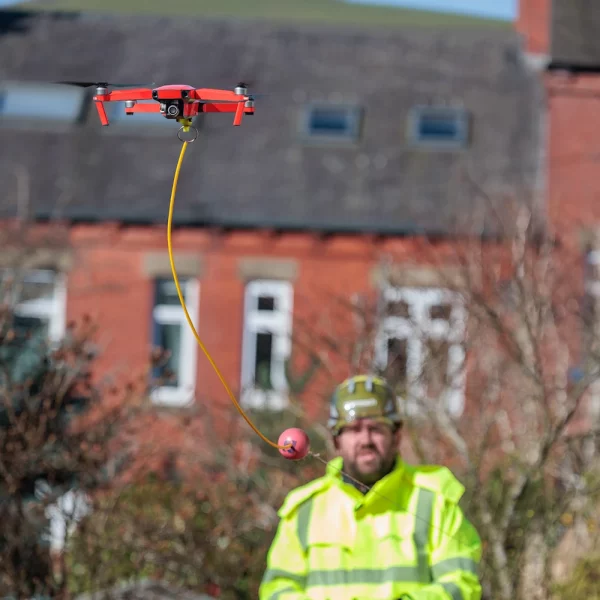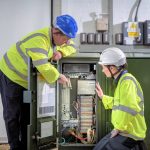Openreach Update on Progress of Innovations in UK FTTP Broadband Build

Network access provider Openreach (BT) has today provided a progress update on the difference that their innovations (e.g. drones, mini-exchanges, LiDAR-powered planning etc.) are making to their ongoing roll-out of Fibre-to-the-Premises (FTTP) based broadband ISP technology. This network now covers 20 million premises.
We start things off with drones. Openreach have been using air drones to help deploy (carry) new fibre optic cables since late 2017, which comes in particularly handy when the fibre needs to be run over difficult or dangerous terrain (e.g. rivers, valleys and steep gorges). The operator has even deployed underwater drones to inspect and repair cables beneath some of Britain’s lakes and rivers.
According to the latest update, the operator’s DroneOps team is now home to 14 trained pilots and they’ve collectively flown nearly 1,200 missions, helping Openreach with more than 400,000km of fibre and connecting more than 100,000 premises in the process. Such missions are said to have saved over 600 days of “dwell time“, avoided more than 100 requests for temporary traffic lights, and helped them skip 50-60km of disruptive duct digging.
Advertisement
After that we come to Subtended Headends (SHEs), which have been around since 2019 (here) and are essentially mini exchanges (i.e. mini-head end or mini-Optical Line Terminals) that can be installed closer to customers – inside new or existing street cabinets). The approach is a useful way of extending the reach of a fibre cable by up to threefold and helps to cut down on the need for some other civil works; up to 1,000 additional premises can be reach from a single SHE.
The latest data reveals that Openreach has now installed 1,200 fibre-boosting nodes (SHEs) like this, saving an estimated £120m and 8,500km of fibre “that we didn’t need to lay” (up from just 1,262km only a couple of years ago). The change probably helps to underline that the operator’s roll-out is now increasingly tackling rural areas, where such methods can be particularly handy.
In addition, there have been a couple of smaller developments. For example, Openreach are now able to survey twice as many building per day and have slashed related costs by up to 65% after deploying Holoplan, which we’ve touched on a couple of times before. Developed by Digitalnauts, this LiDAR-powered tech turns a smartphone into a 3D scanner that allows engineers to create accurate VR models of buildings in seconds – mapping cable routes, equipment, and layouts in real time (saves lots of manual measuring etc.).

Advertisement
Finally, the operator is also now using overblow technology, where new fibres are propelled on a cushion of air through existing ducts. “It’s not only faster, but it uses fewer materials, it’s less invasive for nature, and it dramatically reduces the need for roadworks which disrupt communities,” said Openreach. But we didn’t get any data on this one.
We should point out that some of Openreach’s rivals are also deploying similar approaches, so none of this is strictly unique to the incumbent. But it’s always interesting to see what kind of impact such things can have at scale.
Mark is a professional technology writer, IT consultant and computer engineer from Dorset (England), he also founded ISPreview in 1999 and enjoys analysing the latest telecoms and broadband developments. Find me on X (Twitter), Mastodon, Facebook, BlueSky, Threads.net and Linkedin.
« Channel Islands Customers on Airtel Vodafone Start Migration to Sure






















































Maybe the savings made could go towards digging up the D.I.G. areas that they are dodging at present.
I would imagine that will be a big part of the 5 million premises extra post-2026
Not dodging DIG has been done in my area
Openreach couldn’t innovate if it kicked them right in the face.
Let’s face it. They’re useless at anything but get away with it because they’re big.
I’ve had a cable repaired 5 times in 10 months because they can’t afford to put the cable back on the pole.
Useless
if delivering to 20M premises is ‘useless’ I’d love to hear your opinion of all the other fibre network providers who have got nowhere near that number.
Using drones are pretty neat.
@125us, most other network providers don’t have money chucked at them from local governments like Out of reach seems to get.
More than 50 ISPs have delivered publicly funded work. Your statement simply isn’t true.
Overblowing is the process of blowing a second fibre into a subduct and Openreach have been doing this for a long time. However it can be problematic, can risk damaging the existing blown-fibre cable and is generally disliked by a lot of engineers.
Still waiting for connection. Which need to replaced fiber. But left me with out connection for phone and Internet since July 28.2025..till today
Continually posting similar comments against news articles is not going to help you get connected.
Can I suggest you raise your issue in the forums (if in doubt the “General Discussion” forum is the best place to start), explaining exactly what has happened and the collective knowledge here might be able to point you in the right direction.
I’m in TN12 6HY, some of the 50 properties in our road have had fttp for around 5 years. We were told June, the Sept in emails now it’s we within a year. There has been 4 sets of Openreach works in the pat month still nothing yet for us. Anyone know their plan?
Nobody ever knows their plan. All I know is that it can happen suddenly, as it did for us just this month. We’d seen some build activity earlier in the summer (Complete Telecom and others), but the Openreach postcode checker still showed “by end of 2026” and then “within a year”. The following week it was “ready to order”, which of course I duly did, and we were live in under 3 weeks! So keep hoping…
Thank you A Stevens.
That gives me hope.
We live in the middle bit of a figure 8. They seem to have done everywhere apart from our middle bit!
A question on coverage Mark – you’ve said 20m = 70% of the UK, but that would be if the coverage was only for UK households (28.4m). OR’s coverage includes business premises too, for example. Wonder what the figure would be if we included all business properties / removed business coverage from the OR figure